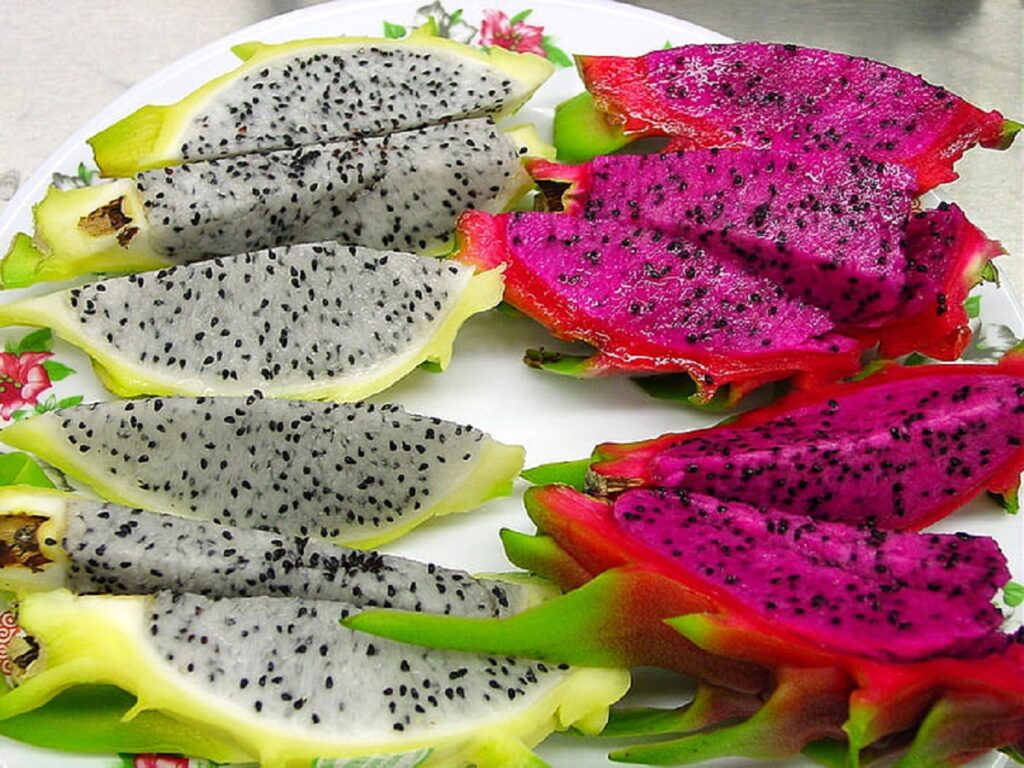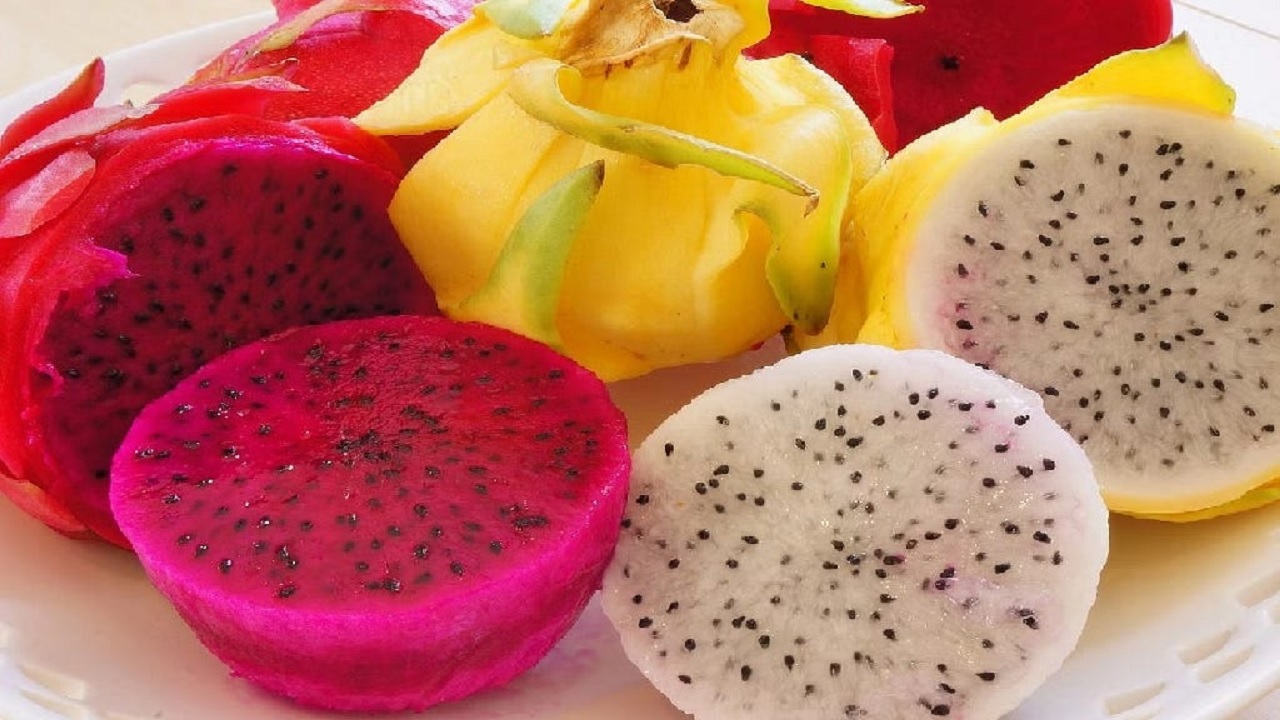Dragon Fruit Yellow vs Red. Image: Medium
Dragon fruit, with its vibrant scales and exotic appearance, has captured the imagination of foodies worldwide. But beneath the striking exterior lie two distinct varieties: red and yellow. While both share the same “dragon” moniker, they offer unique characteristics that set them apart. So, which dragon reigns supreme? Let’s delve into the world of yellow vs. red dragon fruit to help you decide.
Appearance:
- Red Dragon: This iconic variety boasts a vibrant magenta skin, often described as “fuchsia” or “hot pink.” Its scales are larger and sharper, giving it a more dramatic look. The flesh inside is typically a deep crimson, resembling watermelon.
- Yellow Dragon: As the name suggests, this dragon sports a sunny yellow skin, sometimes with a hint of orange. The scales are smaller and more rounded, creating a smoother appearance. The flesh inside is a pale white or cream color, similar to kiwi fruit.
Taste:
- Red Dragon: The flavor profile of red dragon fruit leans towards mild sweetness, with subtle notes of floral and earthy undertones. Some describe it as similar to a less intense kiwi or watermelon.
- Yellow Dragon: This variety packs a punch in the sweetness department. It boasts a honey-like flavor with hints of tropical fruits like passion fruit and mango. Some find it juicier and more refreshing than its red counterpart.
Nutrition:
Both dragon fruits are low in calories and fat but rich in fiber, vitamins, and minerals. However, some subtle differences exist:
- Red Dragon: Higher in vitamin C and antioxidants like lycopene.
- Yellow Dragon: Richer in vitamin A, vitamin C, calcium, and iron. Slightly higher in sugar and calories.
Which Dragon Wins?
The truth is, there’s no clear winner. It all depends on your personal preferences:
- For sweetness: Yellow dragon reigns supreme.
- For unique flavor notes: Red dragon offers a more subtle, complex profile.
- For visual appeal: Both are stunning, but the red dragon might have a slight edge with its dramatic color.
- For nutrition: Both offer valuable nutrients, with yellow dragon slightly edging out in terms of vitamin A, calcium, and iron.
The best way to decide is to try both. Experiment in different recipes, from smoothies and salads to desserts and savory dishes. You might be surprised by which dragon you find yourself favoring.
Vermicelli: Secret Journey of Noodles, Unraveled
Bonus Tips:
- When choosing dragon fruit, look for firm, unblemished skin with scales that give slightly to pressure.
- Store dragon fruit at room temperature until ripe, then refrigerate for up to a week.
- To cut, simply slice it in half lengthwise and scoop out the flesh with a spoon.

Frequently asked questions about Dragon Fruit Yellow vs Red:
Which is better Red or Yellow dragon fruit?
There’s no definitive answer to whether red or yellow dragon fruit is “better” as it comes down to personal preference. Both offer unique qualities that might appeal to different people:
Red Dragon Fruit:
- Sweeter than yellow: If you crave a more intense sweetness, red dragon fruit could be your winner.
- Subtle, complex flavor: It offers floral and earthy undertones for a more interesting taste experience.
- Higher in vitamin C and lycopene: This could be more appealing if you specifically focus on those nutrients.
Yellow Dragon Fruit:
- Sweeter and juicier: If you prioritize pure sweetness and refreshingly juicy fruit, yellow dragon fruit takes the crown.
- Fruity flavor notes: The hints of tropical fruits like passion fruit and mango offer a distinct and vibrant taste.
- Richer in vitamin A, calcium, and iron: This makes it a better choice if you focus on those specific nutrients.
Brussels Sprouts and Sweet Potatoes
What are the pros and cons of dragon fruit?
Pros:
- Rich in nutrients: Dragon fruit, both red and yellow varieties, are low in calories and fat while boasting high fiber content, vitamins (C, A, B), and minerals like magnesium and iron.
- Antioxidant powerhouse: Packed with antioxidants like vitamin C and lycopene, dragon fruit may help combat free radicals and potentially reduce inflammation and the risk of chronic diseases.
- Potential prebiotic benefits: The high fiber content in dragon fruit can promote the growth of good gut bacteria, potentially aiding in digestion and immune health.
- Versatile ingredient: Dragon fruit can be enjoyed fresh, frozen, or dried and can be incorporated into various dishes, from smoothies and salads to desserts and savory meals.
- Low glycemic index: Both red and yellow dragon fruits have a low glycemic index, making them suitable for individuals managing blood sugar levels.
- Unique and delicious: Dragon fruit offers a unique and refreshing flavor profile, ranging from mild sweetness with floral notes (red) to intense sweetness with tropical fruit hints (yellow).
Cons:
- Limited availability and higher cost: Dragon fruit can be more expensive than other fruits due to its limited cultivation and transportation demands.
- Difficult to prepare: Cutting through the thick skin and removing the numerous black seeds can be challenging for some people.
- Potential allergic reactions: Although rare, some individuals may experience allergic reactions to dragon fruit, manifesting as swelling, hives, or digestive issues.
- Laxative effect: The high fiber content in dragon fruit may cause digestive discomfort like bloating or diarrhea in individuals unaccustomed to high-fiber diets.

